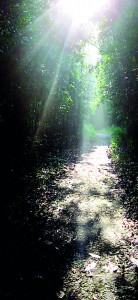Rainforests of Sri Lanka
 Sri Lanka has great diversity of forest ecosystems due to the spatial variation of rainfall, altitude, and soil type. Under the broad category of forests, it can subdivided in to different ecosystems as tropical-wet-lowland-evergreen forests, wet-sub-montane forests, tropical-dry-mixed-evergreen forests, and tropical-moist-evergreen forests but thorny-shrub forests are the main type found naturally in Sri Lanka. Among those forest types Tropical wet lowland evergreen forest plays important role as rainforests in Sri Lanka. Rain forests range in elevation from 0 – 1000 m in the southwestern part of Sri Lanka with a great diversity of flora and fauna.
Sri Lanka has great diversity of forest ecosystems due to the spatial variation of rainfall, altitude, and soil type. Under the broad category of forests, it can subdivided in to different ecosystems as tropical-wet-lowland-evergreen forests, wet-sub-montane forests, tropical-dry-mixed-evergreen forests, and tropical-moist-evergreen forests but thorny-shrub forests are the main type found naturally in Sri Lanka. Among those forest types Tropical wet lowland evergreen forest plays important role as rainforests in Sri Lanka. Rain forests range in elevation from 0 – 1000 m in the southwestern part of Sri Lanka with a great diversity of flora and fauna.
These forests are characterized by the dense canopy of tree species reaching 30-40 m in height with the emergent rising 45m above the canopy layer. Unlike the other forest types in Sri Lanka rainforest are characterized by 5 main canopy layers as Emergent layer, Canopy, Mid canopy, Understory and Forest floor. Woody lianas form an intricate network inside the forest area. Trees bears some unique features as rainforest tree species show greater adaptation for long lasting rain falls, the leaves are even and have drip tips that allows excess water to fall off from the leaf surface. Trees are green throughout the year and since there aren’t any significant climatic variations within a year, trees continue to grow all round the year without shedding leaves at a specific time. Root systems of the plants are shallow because majority of the nutrients are present on the surface of the ground soil layer. Many roots become buttress stems to support these trees and prevent them from falling due to the shallow root system.
These amazing lands are exceptionally rich in biodiversity which accounts for many endemic flora and fauna types in Sri Lanka. Some of the endemic fauna are highly localized inside the forest itself which results in an exclusive biodiversity within the rainforests itself. Sinharaja is one of the hot spots and accounts for 11,280 hectares while Kanneliya-Dediyagala-Nakiyadeniya (KDN Complex) extends up to 10,139 hectares. These forests are important not only because they biodiversity hotspots but they also serve as an important catchment for the main rivers down south.
Kanneliya forest can be identified as the highest woody species rich wet zone forest while it provides a habitat for many endemic fish species in Sri Lanka. Some threatened amphibians are also associated in the water ways that flows through the forest. The Sinharaja forest is also important because of the high spices richness and large number of unique and threatened species that it hosts.
When observing the climate of the rainforests, it does provide the ideal conditions for tropical evergreen forest tree species. An average temperature is approximately 23.6’C and annually receives more than 2500mm rainfall to the forest lands during the binaural monsoons. Most of the soil groups that can be found from rainforest is Red Yellow Podzolic Soils with clearly distinguishable horizons that vary with the soil depth. Little accumulation of Organic matter can be observed in the soil. Rainforest soil is a poor nutrient pool as many of the nutrients are attracted to the plant which has a greater demand for faster growth.
This series of articles will discover the some important aspects and details about rainforests in Sri Lanka along with the picturesque photography collections of rainforests. Under this thread of side articles we will explore the thematic areas regarding the rainforest ecology and its functioning in an ecosystem. Also this will cover the broader aspects of rainforest conservation and management and its sustainable usage in many industries that have strong links with rainforests in Sri Lanka.
Follow @timesonlinelk
comments powered by Disqus






















